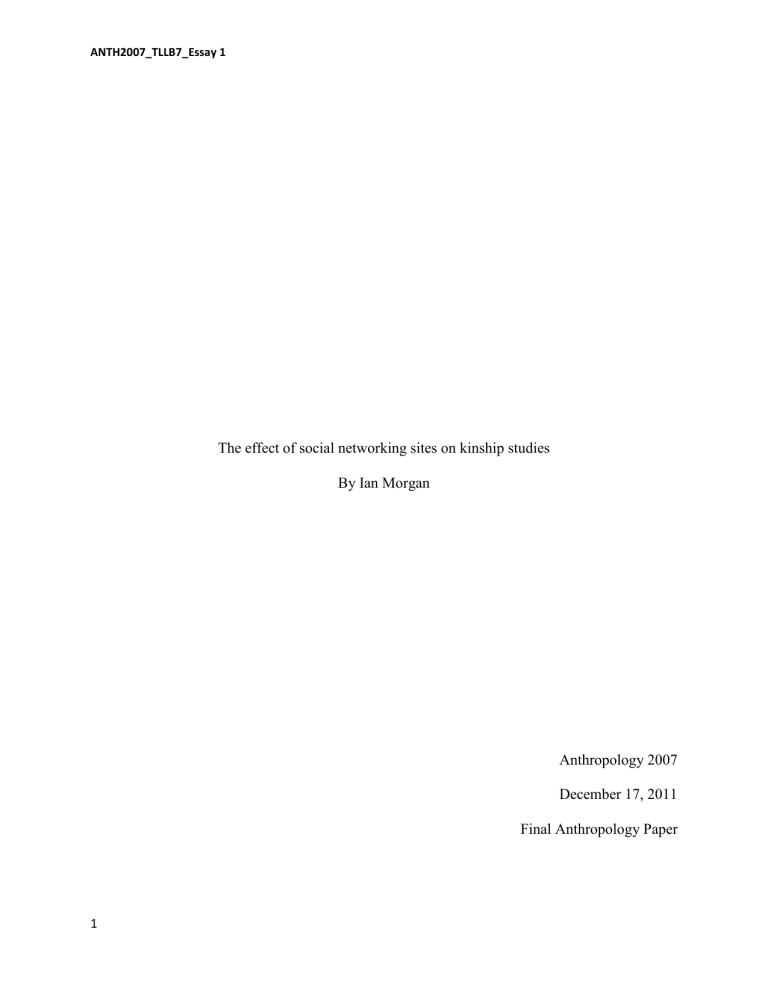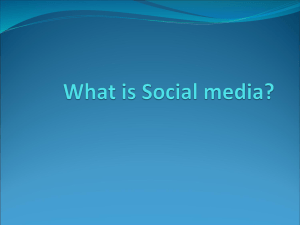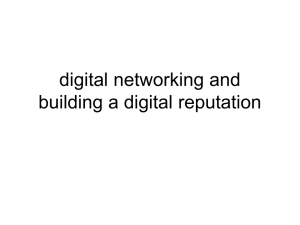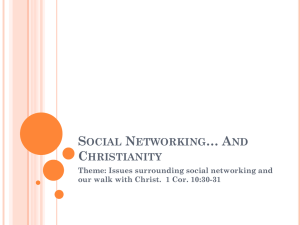Final Facebook

ANTH2007_TLLB7_Essay 1
The effect of social networking sites on kinship studies
By Ian Morgan
Anthropology 2007
December 17, 2011
Final Anthropology Paper
1
ANTH2007_TLLB7_Essay 1
The rise of internet social networking sites such as Facebook, MySpace, or Friendster provokes, at least in my personal experience and conversation, a backlash against the “real” status of the interactions established and/or conducted online. There is a definite discrepancy between those that view social networking sites as shallow platforms for inconsequential chatter in a “fake” world (i.e. online) and those that consider interactions on these sites to be sincere and significant extensions of relations in the “real” world (i.e. offline). This criticism seems inspired by the familiar romantic apprehension that characterizes any major technological step forward; digital cameras displaced the Polaroid, e-mail ousted the letter, and video killed the radio star. In each case, a devoted reactionary core resisted the unrelenting drive of technology in an effort to maintain a dying connection to the past. However, social networking sites occupy a unique place within this paradigm of technological advancement. Like the effects of e-mail on communication, social networking sites are completely transforming how people connect, interact, and relate to one another. In a globalizing world, the importance of the internet as a tool to establish and maintain contact between persons who otherwise could not is invaluable. As such, recent anthropological research is preoccupied with understanding social networking sites in terms of kinship and relationships. Indeed, as Danny Miller pointed out in a recent lecture, anthropology has always been concerned with the study of “individuals as a social network”
(Miller 2011). Despite the various changes to kinship studies throughout the 20 th and 21 st centuries, from classical theory to descent theory, from alliance theory to the hodgepodge of current research, the focus has always been on establishing and understanding the connections between people (Schneider 2004: 260). As evidenced by various ethnographic contributions by
Miller, Heather Horst, and Christine Hine, social networking sites are both a reflection of offline relationships and also an emergent development of kinship systems specific to the internet. In
2
ANTH2007_TLLB7_Essay 1 his work with Trinidadian Facebook users, Miller illustrates the capacity for social networking sites to redefine conceptions of connectedness as well as ideas of the “home” (Miller 2011).
Furthermore, Horst investigates the relationship between offline and online realms as they relate to identity and personal expression on MySpace (Horst 2010). Meanwhile, Hine follows David
Schneider and Janet Carston in challenging the methods of ethnography which are used to analyze internet communities (Hine 1998). Though each ethnographer approaches the research from a different angle, all acknowledge the offline significance of relationships and interactions conducted online at social networking sites; thus, social networking sites have the capacity to reshape common notions of relationships as well as establish entirely new conceptions of kinship.
Turbulence and confusion marked kinship studies throughout the 20 th
century. The traditional model invented by Lewis Henry Morgan in 1871 proposed a genealogical system based on evolution (Schneider 2004: 260). Though accepted widely for more than fifty years,
Morgan’s theory was gradually deconstructed by several prominent anthropologists. Most notably, E.E. Evans-Pritchard and Meyer Fortes established descent theory in 1953, which declared lineage and bloodlines as the basic structure of kinship systems in the world (Kuper
2005: 164). However, the similarities between descent theory and Morgan’s “natural system”
(Schneider 2004: 261), along with the ineffectiveness of each model in the field, may have inspired the invention of a new method for understanding kinship: alliance theory. Conceived by
Claude Levi-Strauss concurrently with Evans-Pritchard and Meyer’s theory, alliance theory focussed on the exchange of gifts, particular women in marriage, as the foundation of kinship systems (Kuper 2005: 212). Each of these systems represents a structuralist approach to kinship studies, and in turn, each was criticised for not considering the practicality of ethnographic work.
Functionalist anthropologists like Schneider and Carston offered yet another method of kinship
3
ANTH2007_TLLB7_Essay 1 research by focusing not on Euro-centric systems of blood lines and marriage, but on indigenous symbols and cultures as a whole (Schneider 2004: 271, Carston 2000: 3). These radical changes throughout kinship studies are a result both of developing knowledge about ethnographic approaches and of changing social and cultural settings in which anthropologists perform fieldwork. Moreover, these developments have led to a distancing from the classic “blood-line” model of kinship toward a more inclusive notion of relationships.
The findings of Christine Hine are notable for understanding the emergent role of social networking sites in kinship studies. Hine’s article “Virtual Ethnography” analyzes the merit of using traditional ethnographic techniques whilst studying internet communities. Hine does not utilize any of the major social networking sites which have risen to prominence in the last decade.
Instead, she focuses on a small, contained group of biologists who communicate using an archaic gaming system known as MOO (Multi-user dungeon, Object-Oriented) (Hine 1998: 9). Using the game as a backdrop, Hine conducted a series of interviews with the scientists online via their personal game characters. The radical difference between constructing ethnography in person, or in the “field,” and doing so in a technological, internet setting are obvious. Hine questions the moral aspects of the interview:
In presenting the transcript, I was initially at a loss as to whether to disguise the identities of my informants… whose identity would I be concealing? ... This act brought into question the actions of the ethnographer: a basic tenet of ethics in ethnographic research seems to be that the ethnography should not harm those in the setting: just how could the publication of a virtual ethnography conducted in a virtual setting amongst virtual characters, bring harm to anyone real?
(Hine 1998: 9)
The mediation between the reality and unreality of the people, or characters, she interviews forces Hine to conduct the interview and report in a new manner. Hine interprets the actions of her interviewees through an entirely new lens than that of a traditional ethnographer because she
4
ANTH2007_TLLB7_Essay 1 is forced to interact simultaneously with both human and non-human informants (Hine 1998: 14).
This point proves to be the primary one for Hine. She states: “As it becomes harder to discern what is a human effect and what is a machine text… the ethnographer too must play a part in these social developments, and the social study itself is transformed” (Hine 1998: 15). Thus,
Hine concludes that the rise of internet communication technologies has led to the development of communities which do not respond to traditional methods of ethnography; furthermore, these technologies are prominent, expanding, and, most importantly, representative of “more serious purposes” than ever before (Hine 1998: 9). Though Hine does not comment on kinship specifically, her research reveals both the offline significance of social networking sites and the need for a fresh anthropological outlook on these communities.
The elasticity of thought that Hine advocates when considering internet communication and social networking sites is reinforced by other anthropologists. Heather Horst analyses the capacity for social networking sites to shape and define the on- and off-line identity of users. In the chapter titled “Aesthetics of the Self: digital mediations,” from Danny Miller’s book
Anthropology and the individual: a material culture perspective, Horst focuses on a teenage
Facebook and MySpace user named Ann. Horst tracks Ann’s online social networking activities from high school through college, examining how she constructs an identity for herself through the creative constraints of Facebook and MySpace. On MySpace, Ann designs elaborate customized back grounds and effects which define her online persona (Horst 2010: 108). The themes and colors she uses to create this space are reflective of her personal tastes in reality: her
MySpace profile page resembles the layout of her actual bedroom (Horst 2010: 108). Ann relies on MySpace to act as a platform for her public persona, with her profile page acting as a representation of her own sensibilities. As most of Ann’s social network is also involved in
5
ANTH2007_TLLB7_Essay 1
MySpace, her online interactions represent a sizeable portion of her daily social exposure, thus defining her relationships. Upon entering college, Ann shifts from MySpace to Facebook, continuing the social networking process. Unlike MySpace, however, Facebook does not enable users to customize their profiles. As a result, Ann’s narrows her public persona to fit the constraints of the Facebook social network (Horst 2010: 109). Horst notes:
“Ann essentially constructs herself as different configurations of pre-determined selections within the generally acceptable genres of her peers [but]… Just as social network sites provide structures, and in turn, constraints upon the way the self is formed and re-formed online, ordering in homes and dorm rooms are also carried out within tight restraints.”
(Horst 2010: 109)
Ann’s process of self-construction online is based on the boundaries set out by the social networking sites. However, as Horst notes, these social constraints have much in common with offline constraints imposed by parents and authorities. Thus, MySpace and Facebook serve as a medium through which users socialize with an on-line community that is closely tied to their offline kin relations.
Horst posits that Ann creates a “bedroom” through social networking sites (Horst 2010:
104); likewise, Danny Miller suggests in his book Tales from facebook that social networking sites are beginning to assume greater roles as “homes” (Miller 2011a: 35). Miller examines the life of Dr. Karamath, a charismatic Trinidadian whose public life in politics and social reform was cut short by a debilitating disease which left him handicapped and housebound. However,
Dr. Karamath soon discovered Facebook and began developing a broad social network from within and without Trinidad (Miller 2011a). Miller’s study sheds light on the growing role
Facebook plays in establishing a network for people who otherwise would not be able to socialize. Miller notes that the unique features of Facebook enable Dr. Karamath to enjoy authentic, sincere relationships in a manner that could not be achieved in face-to-face interaction.
6
ANTH2007_TLLB7_Essay 1
Dr. Karamath operates his Facebook profile similar to a home; in other words, he relies on
Facebook as his sole means of communication and interaction with the world, inviting people into his web-space as one invites guest into a house. Through his extensive posts, users viewing
Dr. Karamath’s profile would be exposed to “a density and depth of material that gave them considerable insight into the nature and the personality behind it” (Miller 2011a: 34). Miller notes that despite Dr. Karamath’s physical handicaps, “within the land of Facebook he was just as mobile just as articulate as any [user]” (Miller 2011a: 34). Thus, Facebook serves as a leveling apparatus which enables users to socialize beyond their physical bodies and extend their networks across cultures.
Similarly, Miller investigates another Trinidadian Facebook user who uses the social networking site as a means of establishing and maintaining new relationships. Arvind, a poor resident of Trinidad, uses the Facebook game FarmVille as an opportunity to create relationships that otherwise would not exist offline. FarmVille is a farming game in which characters “raise crops” through the assistance of their fellow FarmVille gamers; based on mutual exchange and reciprocity, FarmVille is recognized as one of the most popular games on Facbook, and as a result, in the world (Miller 2011b: 52). Arvind is a quiet student attending junior college in his home town. Described through euphemisms such as “kind” and good-hearted, Arvind is characterized as a person “lacking in any kind of foundational self-confidence” that would enable him to easily engage and befriend his peers (Miller 2011b: 56). This inability to socialize stunts Arvind’s capacity to form new relationships. However, through FarmVille, Arvind discovers a system of socialization that allows him to meet classmates and peers in a setting that nurtures co-dependence and forms bonds. Proving an apt digital-farmer, Arvind amasses a wide range of friends, many of whom are people Arvind encounters in his daily off-line interactions at
7
ANTH2007_TLLB7_Essay 1 school (Miller 2011b: 62). Arvind’s socialization on FarmVille seems to fit into Levi-Strauss’ alliance theory of kinship. Miller’s description of Arvind’s interactions as “advancement through collaboration and reciprocal generosity” (Miller 2011b: 60-61) is reminiscent of Levi-Strauss’ notion of marriage exchange as a means of constructing kinship ties (Kuper 1988: 218). In each instance, mutual gift-giving leads to mutual benefits and thus brings the parties closer together. If one stretches the imagination, it is also evident that FarmVille operates on a similar basis of the incest taboo which Levi-Strauss posits as the basis of alliance theory. Incest taboos force primitive cultures to marry outside of their kin group, thus establishing new bonds (Kuper 1988:
111); likewise, FarmVille forces users to reach out to fellow “farmers” in order to propagate their own crop. Of course, the on-line nature of FarmVille makes for some marked difference between the game and alliance theory. Users, like Arvind, are able to cheat the system by creating false accounts to share with themselves; also, there is a discrepancy between the social gravity of marriage when compared to a computer game. Yet, these differences only highlight the capacity for Facebook to shape ideas of kinship which are influenced by traditional theories and emergent trends alike.
In 2006, Time Magazine named their annual “Person of the Year” as simply “You”
(Time 2006). When everyone from 5 th
graders to centenarians has some sort of social networking site, it seems only logical to assume that the individual is becoming more empowered. However, the sum of the whole in this ever-growing field of Facebook and MySpace users may be more significant than the solitary users. When relationships are established and carried out entirely online, kinship and anthropology as a whole are inevitably affected. Be it through ethnographic techniques that take into account new methods of communication and bonding, through emergent means of persona creation which establishes one’s identity within a social group, or
8
ANTH2007_TLLB7_Essay 1 through the networking of the disabled and dejected who find potential for socialization where previously there was none, social networking sites are impacting kinship studies rapidly and significantly. And though there may be some precedence in anthropology for understanding such interactions, it seems there is a need for a fresh interpretation of kinship and the social networking site.
9
ANTH2007_TLLB7_Essay 1
Bibliography
Carsten, Janet, (2000) “Introduction: cultures of relatedness” from Carsten, Janet, Cultures of relatedness: new approaches to the study of kinship pp. 1-36, Cambridge University
Press, Cambridge
Grossman, Lev, (2006) “You—Yes, You—Are TIME’s Person of the Year” from
TIME
Magazine , December 25, 2006, Cover, Time Inc.
Hine, Christine, (1998) “Virtual Ethnography”
Conference Proceedings of Internet Research and
Information for Social Scientists , 25-27 March 1998, Bristol, UK
Horst, Heather, A., (2010) “Aesthetics of the self: digital mediations” from Miller, Danny,
Anthropology and the individual: a material culture perspective pp. 99-113 Berg, Oxford
Kuper, Adam, (2005) “Descent theory” from Kuper, Adam,
The reinvention of primitive society: transformations of a myth pp. 163-178, Routledge, London
Kuper, Adam, (1988) “Academic Anthropologists and primitive society” from Kuper, Adam,
The invention of primitive society: transformation of an illusion pp. 123-231, Routledge,
London.
Miller, Danny, (2011) “The Anthropology of Kinship Lecture Series”, lecture, 2 November 2011
Miller, Daniel (2011a) “Chapter 3: For whom the bell doesn’t toll” from Miller, Danny, Tales from facebook pp 28-39, Polity, Cambridge
Miller, Daniel (2011b) “Chapter 5: Cultivating FarmVille” from Miller, Danny, Tales from facebook pp 53-64, Polity, Cambridge
10
ANTH2007_TLLB7_Essay 1
Schneider, David M., (2004) “What is kinship all about?” from Parkin, Robert and Stone, Linda,
Kinship and family: an anthropological reader pp. 257-274, Blackwell, Oxford
11






